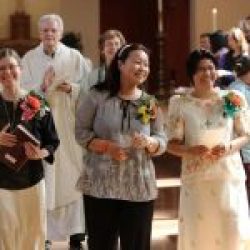By Nancy de Flon | Catholic News Service
For those of us in the Northern Hemisphere, Advent is a time to watch and prepare for the coming of Christ just as vigilantly as we scan the skies for those first tentative signs that the days are slowly but surely getting longer.
For this Advent reflection on Christ our light, I begin with an Easter story, namely, Jesus’ encounter with the disciples on the road to Emmaus. Luke’s Gospel tells us that Jesus, “beginning with Moses and all the prophets … interpreted to them what referred to him in all the Scriptures” (24:27).
While Luke doesn’t offer a detailed list of “what referred to him,” we can reconstruct it, at least partially, by reading selected Old Testament passages in terms of Jesus’ self-understanding.
Jesus knew that his Father had sent him to bring hope, peace, and freedom to a world that desperately needed them. He summed this up in the imagery of light: In John’s Gospel he proclaims, “I am the light of the world. Whoever follows me will never walk in darkness” (8:12). The stage is set for this in the prologue, which describes Jesus as the light that shines in darkness (1:5).
The Gospels portray Jesus deftly employing imagery in his teaching, borrowing especially from the daily life (e.g., agriculture) familiar to his listeners. In a world without electricity, light was a powerful image.
The Old Testament is rich in nature imagery, and Christian tradition interprets various references to light as prophecies of the coming Messiah. They are likely the ones Jesus used to explain the prophecies about himself to the disciples going to Emmaus.
We can greatly enrich our Advent prayer by considering some of these passages, especially those that appear in the Advent and Christmas readings and other liturgical texts.
From Isaiah, the great Advent prophet: “The people who walked in darkness / have seen a great light; / upon those who dwelt in the land of gloom / a light has shone” (9:1).
This is liturgical drama at its best with the lector at Christmas midnight Mass proclaiming to an assembly in the complete absence of daylight. In its context at this Mass, it is clear that the Christian tradition interprets that “great light” to be Christ.
But we needn’t wait until Christmas to find a text identifying Christ with light. An antiphon for Evening Prayer I for the first Sunday of Advent says that the day on which the Lord comes “will dawn with a wonderful light.”
Later, at the Christmas Mass during the day, the Gospel acclamation sings of a holy day that “has dawned upon us … today a great light has come upon the earth.”
This magnificent, poetic text is among many that have inspired great composers, in this case, the 16th-century composer Palestrina, whose motet “Dies sanctificatus” contains glorious word-painting of the great light “descending” (the original word) upon the earth.
In a composition more familiar to most of us, Handel in his “Messiah” sets a text from Isaiah that begins with a brooding “For behold, darkness shall cover the earth” and builds up to music that vividly paints a picture of the sun rising over the horizon and gradually flooding the world with light: “But the Lord shall arise upon thee.”
Jesus is the light that shines on the world and on each of us individually, even into the darkest corners of ourselves that need healing from wounds or from sin. Hopefully, supported by this great wealth of images proclaiming Jesus as light, our prayer will be enriched during the Advent season and throughout our lives.
Nancy de Flon is a freelance editor
Advent of Accompaniment
This Advent season, the Diocese of Syracuse is inviting faithful to join in an Advent of Accompaniment. Throughout the season, resources and reflections will help us all consider how we might walk with our brothers and sisters on the journey of faith. Here, a reflection from Lisa Hall, diocesan Director of the Office of Family/Respect Life Ministry; watch her original video reflection with Syracuse Catholic Television at youtube.com/syrdio.
These are literally some of the darkest days in our calendar year. It’s dark in the morning as I get up, and it’s dark as I leave work to head home. All that darkness can be depressing, sometimes even frightening.
Shame, guilt, and secrecy can leave a darkness in our soul. I’ve been blessed to work with Project Rachel, a ministry which accompanies those who regret their involvement with abortion and who seek peace and healing. We invite these brave people to bring their shame and guilt to Jesus, the true source of healing and light. We walk with them and encourage them to seek peace and restoration with God, the Church, and one another. It’s an amazing gift to see God’s grace at work — such an honor and a privilege.
And this is what each of us is called to during Advent — to wait with one another, walk with one another, and lead one another expectantly to Jesus, our hope and our light. There is no darkness that the love and mercy of Christ cannot overcome. I encourage you to trust God’s word when he tells us in John’s Gospel, “the light shines in the darkness, and the darkness has not overcome it.”
Wishing you and your families a blessed Advent season filled with the knowledge of God’s goodness, light, and love.







